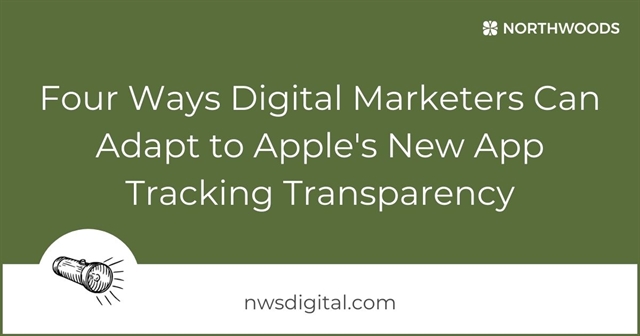By Northwoods Team
October 10, 2022
6 Minute Read
Updated: Oct. 10, 2022
Originally Published: Aug. 19, 2021
Google plans to phase out third-party cookie tracking in its Chrome browser sometime in late 2024, a move intended to better protect user privacy.
Apps and companies that use third-party cookies to aggregate consumer data are under continued pressure to be more transparent. The public is more aware than ever of the fact that hyper-personalized ads come with a loss of privacy – and more suspicious of how their personal information is being used. The Safari and Firefox browsers have banned third-party cookies since 2013. App tracking restrictions and transparency notifications continue to be released across the board.
In a post on Google’s Chromium blog, Justin Schuh, Director of Chrome Engineering, said "Users are demanding greater privacy – including transparency, choice, and control over how their data is used – and it’s clear the web ecosystem needs to evolve to meet these increasing demands.”
On the other side of the divide, marketers are under pressure to adapt as the foundations of their advertising and interest targeting slip out from under them. The future is already here; how will marketers respond to such a sensitive advertising environment?
How First-Party Cookie Data Is Collected
Transparency, choice, and control are the new keywords of online marketing strategy. They are integral to first-party data collection, that is, of Personally Identifiable Information and other demographic information. The brand collects this information directly from the customer with full customer consent via brand-specific interactions. Simply logging into a brand account – signing into your Amazon Prime account to begin shopping, entering your phone number into your Uber app to call a ride are performative uses for the brand’s first-party cookies.
Like third-party cookies, first-party cookies are installed in the name of user experience and convenience. These cookies are site-specific code snippets that are prompted and then stored on your device when you begin a session on a brand's website. First-party cookies retain your login information, basic user data, and your preferences, such as which marketing emails you want to receive and the language you use online.
First-party cookie data from a website can be summed up as the standard analytics data a company studies to monitor its site performance based on user interaction:
- How often does a given user visit your site?
- Which pages did the user visit?
- Where is the user located?
- Which items landed in the shopping cart?
First-party cookie data, leveraged correctly, can be very robust. But for marketers, first-party data exists in a vacuum.
Let’s say you added a Patagonia sweater to your Amazon shopping cart but logged off before making the purchase. With third-party cookies enabled, you'd likely see a banner ad for that same sweater or a pop-up for Patagonia.com when you pull up your browser to read the news later in the day. If you then log back in to Amazon and complete the checkout process, third-party cookies are attributed to Amazon’s sale.
Without third-party cookies, the targeted pop-ups and banners would not follow the customer to the evening news.
How to Cultivate First-Party Cookie Data Collection
With the end in sight for third-party cookie data collection, it's time to focus on how to better gather first-party data. The smoothest transition to more effective first-party, consent-driven advertising involves rewarding users for yielding information and thus cultivating loyalty. Real first-party power lies in having your customers create an account to interact with your site.
For example, Instagram lets users without accounts view public profiles and tagged photos for a certain period of time. Beyond that, Instagram bars further scrolling and prompts creation of an account, which rewards sign-ups with the ability to like, comment, view private profiles, and go deeper into the app.
Another example is an e-commerce platform. On the popular home decor site Wayfair.com, users can browse and purchase as guests. But Wayfair rewards account holders with discount codes, personalized product suggestions, the ability to save items to wish lists, and the storage and retention of their payment and shipping information.
Essentially at every sign-up or login, your customers clearly consent to be plugged into the experiences your website or app offers. The more ease, personalization, and reward they enjoy for being a returning customer, the more first-party data you'll be able to collect – thereby increasing the customer’s lifetime value to your brand.
Their information is then stored in a point-of-sale or CRM or easily collected through a data management platform (DMP).
Going forward, every tracked video view, photo comment, product purchase or form fill is a valuable data point. That data should influence your content creation. If more of your consenting customers watch your brand’s videos, release more videos. If certain photos fail to engage your users, redirect your efforts. If a product has a higher profit margin, use it in ensuing promotional materials. If a particular webpage receives a higher volume of form submissions, emulate its design and content on other lead-generation pages.
How to Leverage First-Party Cookie Data
Subscription data, such as email list sign-ups and coupon requests, open sweeping insight into the type of people who want to hear from your brand often. If your audience is, say, primarily female or mainly located in a certain geographic location, employ a contextual marketing strategy. That is, couple CRM data with PPC advertising keywords, or partner with sites with similar audiences to craft a more catered, less intrusive approach to potential customers.
This data can also direct you to certain channels. If, for example, you offer legal consultation services and your users live primarily in urban/suburban areas with long commutes, radio or podcast advertising might be an ideal secondary strategy, as drivers can’t watch videos or read newsletters.
Finally, first-party cookies allow for content recommendations. Leveraging your data management platform with another MarTech tool, such as a proprietary recommendation engine, can help you suggest content to your customers based on their on-page interactions. This solves the problem of first-party data marketing in a vacuum. Aggregating data from customers who frequent one section of your website may show that they also purchase from another category (e.g., evening gowns and jewelry pages). Or the data might indicate that customers active on your brand’s social media account are more likely to share your blog posts and updates with their networks.
Accessing DMP data for these types of customers helps maintain a marketing flow in a more logical way than chasing third-party data across platforms and sites.
How to Get Started
For first-party data marketing, start where you are. Cater to the customers who engage with your product or service and begin to analyze and apply the data in a contextual way. This is old-school marketing, but it’s tried and true, and what’s more, it’s authentic. Track your customers in a way that shows that their purchase behaviors inspire your strategy, and not the other way around.
If you need assistance with your first-party data marketing or analytics, or aren’t sure how to start, reach out! We’re happy to help.
Related Blog Posts

A cookieless future is likely still coming. Here are strategies to get your hand out of the cookie jar and make a successful transition to a profitable future!

While Apple’s release of iOS 14.6 comforts users concerned about their online privacy, it’s also triggering headaches for marketers accustomed to leveraging user data to target ads and messaging. Here are four ways digital marketers can adapt.

Today's highly targeted marketing campaigns require more audience data than in the past. To convert your specific audience, you must first know exactly who they are and then craft effective messages and approaches to reach them. These five audience targeting strategies can help you achieve success.